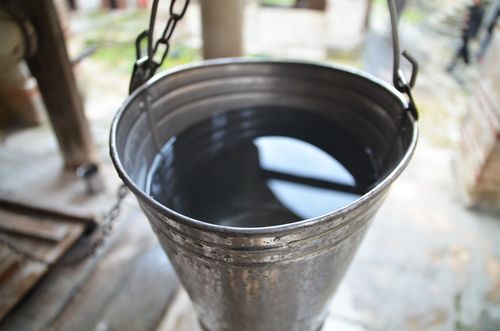News stories about contaminated water over recent years have brought the issue of childhood lead poisoning to the forefront. While the situation in Flint Michigan resulted when the main water supply became contaminated, lead pipes continue to be the most significant threat to children across the nation.
Despite efforts to ‘clean up’ lead in this country, the Center for Disease Control (CDC) says there’s still a big problem. The CDC says there are at least four million households where children are being exposed to high levels of lead. This exposure comes partly from drinking, bathing, and cooking with water delivered through lead pipes. Some older homes also still have paint. Lead poisoning occurs by consuming it or inhaling it as dust.

Why Young Children Are at the Greatest Risk
Young children are still growing and developing. Unlike adults, they spend a lot of time on the floor and put things into their mouths. The sweet taste of lead makes it even more appealing to kids. They are more likely to breathe in lead-containing dust or put chips of peeling paint into their mouths. You can’t look at a child and determine they have lead poisoning. They don’t look or act sick.
Once symptoms do occur, they include sleep problems, headaches, abdominal pain, memory loss, abdominal cramps, kidney dysfunction, numbness or tingling in the arms or legs, and behavioral problems. Lead poisoning also causes delayed growth and a loss of developmental skills.
Getting to the Source
If you are thinking of buying an older home, try to find out about the pipes and the paint before purchasing it. If you can’t, consider the cost of upgrading it in the cost of the property. Any home built before 1978 could have been painted with lead paint. This is the year that the government banned the use of lead-based paints. Homes built before 1986 could have lead pipes, fixtures, and solder. Even if you have been living in an older residence for some time with no sign of lead poisoning, you still need to deal with both of these issues.
– Lead Paint
You can purchase a DIY test kit to determine if the paint in your home contains lead, but it’s better to have a professional test using X-ray fluorescence. These kits have not been approved by the U.S. Consumer Product Safety Commission for effectiveness. Also, many old houses have had layers of paint applied one over top of the other. Although the top layer might not contain lead, the one several layers below might.
If you have lead paint, you can either have it professionally removed or cover it. Never attempt to sand or scrape lead paint. This creates dust and a serious exposure hazard. If it isn’t cracked and peeling, sealing it is probably the best option. Just don’t use ordinary paint. There are a number of encapsulates on the market design to keep the lead from coming through. This is something that ordinary paint doesn’t do.
If there are cracks or chips in the paint, hire a professional to have it removed. There is no safe way to encapsulate the paint if there are chips or it’s started to peel. A professional can remove the paint without putting you at risk from the dust created.
– Lead Pipes
Dealing with lead pipes is a more complex venture. You can’t determine that your pipes are lead based on the date of construction alone. Some cities passed laws against lead pipes before the federal law changed.
One simple test is to use a screwdriver to make a scrape. Lead will turn shiny and is soft. Another good test is to apply a magnet. If it’s steel, the magnet will stick. If it’s made of lead or copper, it won’t. The problem with these tests is that testing one or two pipes that are visible doesn’t guarantee the rest of the pipes are the same. Some of the pipes might have been replaced at a different time than the rest of the pipes.
Replacing the pipes is disruptive, not to mention extremely expensive. In addition to the pipes, older brass faucets and the solder used to hold pipes together can also have lead in them. Replacement means paying for all new pipes and fittings as well as paying a professional to remove and re-install them.
Another alternative that is more cost-effective than pipe replacement is pipelining. This method restores corroded water piping without disrupting your pipe system. The pipes are lines with epoxy to allow safer delivery of drinking water. It also extends the life of your pipes, and it takes less time than replacement.

Lead: Beyond Your Homes Plumbing
Making buyers of older homes aware of the potential dangers of lead pipes is a start. But what about your child’s school or daycare? Any older building that caters to child care puts children at risk if the pipes aren’t checked and either replaced or given an epoxy coating.
Another problem that many people aren’t aware of is that of contaminated coming into their homes. The Environmental Protection Agency (EPA) requires community water systems to provide water quality reports annually. In addition, the organization requires public water systems to alert their customers to any potential problems with their drinking water. These regulations can give customers of water companies a false sense of security in some cases. The EPA admits that they give other public health issues a higher priority than enforcing the demand for water testing.
An estimated 4 million people are living with an unknown contaminant in their drinking water. The water comes from about 9,000 small water systems which fail to test properly for lead over a period of six years. Of those, over 25% had repeat lead-testing violations.
Like so many systems designed to protect our health and wellbeing, money is often the cause of these companies not performing the required tests. As a result, schools and daycares across the country have lead-contaminated water.
There’s also a risk to adults, especially pregnant women and their babies. Infants exposed to lead prior to birth may be born prematurely, have a lower birth weight, and slowed growth. Lead poisoning also puts adults at risk for:
- High blood pressure
- Memory problems
- Joint and muscle pain
- Headaches
- Mood disorders
- Abdominal pain
- Reduced sperm count and/or abnormal sperm

Reduce Your Risk of Lead Poisoning
There are some steps you can take to minimize your risk of lead poisoning. This is important for you, your children, and every member of your family.
– Test Your Well Water
Lead occurs naturally in the earth and exists in any area of the environment. Although it rarely occurs naturally in your drinking water, many older wells have lead in the ‘packer’ used to seal the well. Lead can also come from corrosion of the pipes and fixtures getting into the water. Have your well tested at least once every year.
– Change the Fixtures and Fittings
An epoxy pipelining coats and seals lead pipes to keep lead out of the water. But brass fittings can contribute to the problem. Change any old fixtures and fittings to new ones that are lead-free.
– Use the Cold Water
Only use cold water for drinking, to cook food, and to mix with baby formula.
– Use a Water Filter
Make sure it’s designed to remove lead. Change the filter as recommended.
– Flush the Pipes Before Using the Water
Run the water for a full minute before drinking the water, using it to bathe, or to wash dishes or laundry.
– Get Information About Your Child’s School or Daycare
Kids love going to the water fountain. Make sure the one at your child’s school isn’t making them sick. Ask the school if the water has been tested. Your child spends a lot of time there and probably comes into contact with more water than they do at home.
Lead pipes and paint are the most common source of lead poisoning, but they are far from the only sources. Some ceramic dishes, jewelry, antiques, and even bullets contain lead. When you purchase items from other countries, keep in mind that they aren’t under EPA regulations. Spices, folk medicine, and cosmetics may contain lead. While the amount found in these products is usually minimal, it’s better to minimize your exposure as much as possible.
If you’ve been thinking about buying an older home or you already live in one, you are more likely to have lead pipes than with a newer home. Take every precaution to ensure the water you and your family use to prepare food, bathe, and to drink is safe. Lead is a toxin that causes very serious issues, especially in young children and infants.
Contact The Pipeline and Plumbing Pros at San Diego Pipelining for Help!
Contact San Diego Pipelining to learn more about our pipelining solutions. Pipelining is a cost-effective alternative to replacing lead pipes that doesn’t disturb your home and your routine. We have pipelining solutions for a variety of water pipe. Don’t put your family’s safety at risk. Let us help you deliver safe water to your home.
